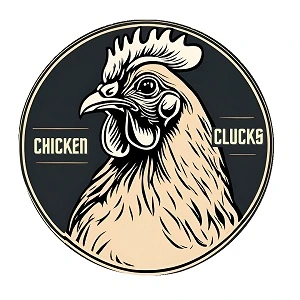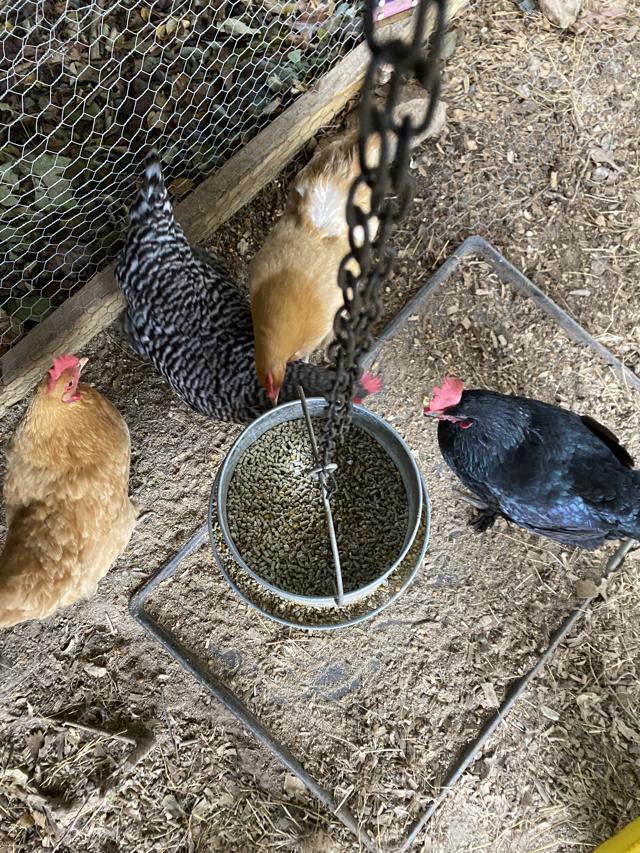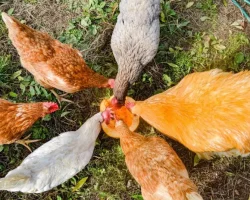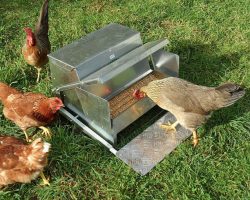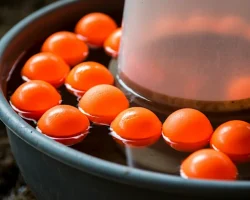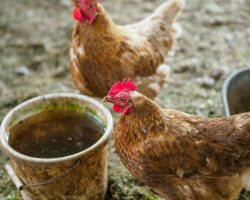Choosing the right chicken feed is important for your flock’s health and productivity. This guide covers the basics of different feed types, nutritional needs, and how to choose the best feed based on age and breed. The main focus is on laying hens. Also, we’ll discuss organic and non-GMO options. Whether you’re a beginner or experienced, this guide will help you make the best choice for your flock.
Why I’m the Chicken Feed Expert
I’m a chicken nutritionist with over 10 years of experience at an international company. I’ve created feed recipes for over a billion chickens worldwide. My job is all about keeping chickens healthy and productive. I’ve helped farmers improve egg production and worked with large farms to boost health and growth. I enjoy working with small family farms, where raising chickens is more about passion than profit. I’ve been lucky to share meals and celebrations with them!
Thanks to my career and experience with backyard chickens, I’ve learned everything there is to know about chicken feed. I’m excited to share my knowledge with you.
Every chicken has different nutritional needs
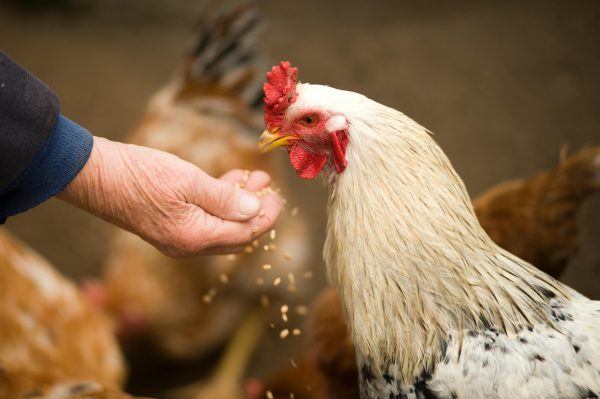
The right chicken feed depends on your chickens’s age, breed, and purpose:
- Chicks: Especially during the first weeks of life (2-3 weeks), feed them a starter feed rich in protein (20-24%) for good growth and a healthy immune system.
- Pullets: After a few weeks, switch to a grower feed with 16-18% protein to support balanced growth. Steady reproductive organ development will make your hens lay many eggs later in life.
- Layers: Once your hens start laying, use layer feed with higher calcium (> 3%) to support strong eggshells.
- Broilers: For meat chickens, use broiler feed with more protein to help them grow quickly. Starter feed (20-24% protein) and Grower/Finisher feed (16-19% protein) are ideal.
Look for this information on the feed label.
Complete chicken feed vs Concentrates
Feed types include complete feed and concentrate:
- Complete feed is as the term says ‘complete’. It is a balanced feed with all the nutrients your chickens need. You don’t need to give other chicken foods, like kitchen scraps, grains, hay, or supplements. Small amounts of treats are okay, but stick to a maximum of 10% of your chicken’s diet. Otherwise, your chickens might lay fewer eggs.
- Concentrate is protein-rich and you need to mix it with other ingredients. You can often find the mixing instructions on the feed bag. For beginners, I recommend complete feed because mixing concentrates properly takes experience.
Choose the Right Feed Form
Chicken feed comes in various forms, each with its benefits:
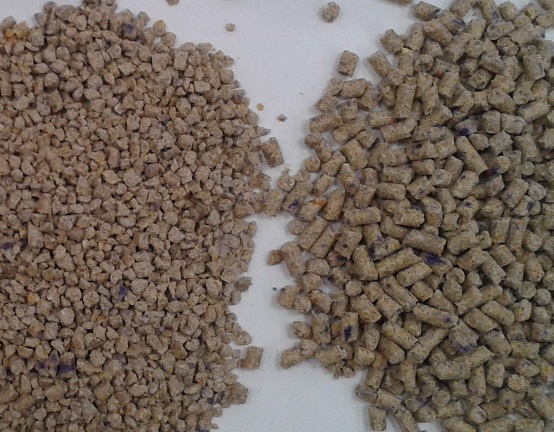
- Pellets: These minimize waste and mess, making it easier to keep the coop clean. Each pellet has balanced nutrients, so your chickens get everything they need. They should have little dust.
- Crumbles: These are smaller pieces of pellets. They’re great for young birds or for slowing down older birds that eat too fast.
- Mash: This is ground feed, often without heat processing. Commercial layer farms use mash to slow down hens’ eating. While it’s suitable for hens at all stages, it’s not recommended for young birds (< 3 weeks) or broilers that need to grow quickly. Mash can also be messy and harder to manage for beginners.
Proper feed management is key to making sure your chickens eat enough and don’t waste feed. An automatic feeder can help with that. Make sure your chickens empty their feeders once a day. This helps to keep feed fresh and well-balanced.
Understanding nutrients and ingredients
Nutrients are essential for your chickens’ health, like protein. Ingredients, like corn, are mixed to make a feed.
Nutrients
Here are the main nutrients in feed to look for:
- Protein is important for growth and egg production. Young chickens need more protein (> 19%).
- Fat has the highest amount of energy.
- Carbohydrates also provide energy mainly come from grains.
- Fibre can help with digestion, but too much isn’t good.
- Minerals like calcium (Ca) and phosphorus (P) are essential for strong bones and eggshells. Calcium in layer feeds is higher (>3%) than in other feeds (< 1%). Use chicken grit for extra calcium and better digestion.
- Vitamins are essential in small amounts for overall health.
Check the nutrient levels on the feed label to check feed quality. Generally, higher nutrient levels mean better quality. However, don’t rely solely on the label to make a decision. Even experienced nutritionists, like me, need further analysis. The best is to read reviews, and look at the health of your flock.
Ingredients
Feed ingredients are mixed to create feed. Many feed ingredients are byproducts from the human food industry, like soybean meal and sunflower cake. It is nice to know we are not just throwing these byproducts away but using them for a good purpose.
Common feed ingredients are:
- Grains: corn, wheat, wheat bran, barley, and others
- Protein sources: soybean meal, sunflower cake, rapeseed meal, fish meal, and meat and bone meal
- Fats and oils: soybean oil, sunflower oil, lard (pig fat), and tallow (cow fat)
- Minerals: salt, limestone, and others
- Premix: contains vitamins and minerals
- Additives: pigments to color the yolk, acids to improve digestion, mold inhibitors, enzymes, and more
The U.S. Food and Drug Administration (FDA) enforces strict regulations on meat and bone meal use in poultry feed, and it is banned in ruminant feed to protect public health. Remember BSE (mad cow disease)? Cows consuming cow proteins (prions) led to the deaths of both cows and humans in the past.
Choosing organic and non-GMO chicken feed, is it worth it?
Some chicken keepers may consider organic or non-GMO feeds for environmental or ethical reasons. However, keep in mind that regular (non-organic, GMO) feeds are also a perfectly good option. They are nutritionally similar, equally safe, and often cost less.
Safety of all feeds, also non-organic and GMO, is guaranteed by general legislation on food safety. It includes maximum pesticide levels in feed and food. In the U.S., legislation is made by the United States Environmental Protection Agency (EPA). In the EU, by the European Food Safety Authority (EFSA).
Choosing organic and/or non-GMO are two separate decisions. Let’s first explore what ‘organic’ and ‘non-GMO’ mean.
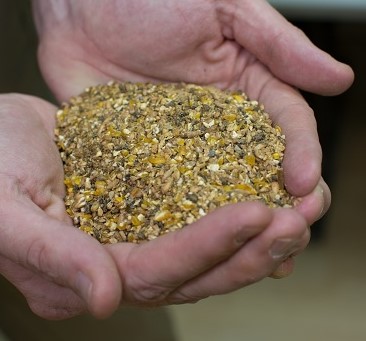
Organic chicken feed
Organic chicken feed is grown without synthetic pesticides or fertilizers. It’s good for the environment, but can more more expensive. This is due to lower crop yields and more labor needed. Look for official certifications like the USDA Organic seal. If not present, ‘organic’ may be an empty claim.
Organic products are certified by the USDA after inspection of the farm and/or processing plant. There is legislation that determines when a product may be labeled as organic:

- “100% organic”, and a USDA organic seal, it is 100% organic and certified.
- “Organic” and a USDA organic seal, means at least 95% of ingredients are certified organic.
- “Made with Organic Ingredients” must contain 70 to 94 % organic ingredients and may not display the USDA organic seal.
- Products with less than 70 % organic ingredients does not qualify for an organic label and may only use the word organic within its ingredients list to identify which ingredients are organic.
For more information on organic products and legislation by the USDA, click here.
Non-GMO chicken feed
“Genetically modified organisms (GMOs) can be defined as organisms (plants, animals or micro-organisms) in which the genetic material (DNA) has been altered in a way that does not occur naturally by mating and/or natural recombination” – World Health Organization (WHO).
Click here for more information about GMOs by the WHO.
Non-GMO feed is made without genetically modified ingredients. This a personal choice more related to ethical, than environmental reasons. Non-GMO feed is often more expensive, equally safe, and nutritionally similar to regular feed.
The environmental impact of non-GMO feed is a topic of debate. Overall, non-GMO feed isn’t necessarily “better” for the environment. It often requires more land, water, pesticides, and chemicals. In addition, GMO crops can also be grown sustainably.
Key Takeaways
- Organic and non-GMO feeds offer no nutritional benefits to your chickens compared to regular feed.
- Regular feeds are equally safe for you and your chickens.
- Certified organic and non-GMO feed is a personal choice driven by ethical or environmental reasons.
- Consider your budget and preferences when deciding. Organic and non-GMO feeds are often more expensive.
Ultimately, the best choice is the one that aligns with your values. Whatever you decide, the most important factor remains the health and happiness of your flock. Luckily, for your chickens, these choices don’t matter. Non-organic and GMO feed is equally safe for your chickens, eggs, and you!
Which chicken feed brand should you choose?
There’s no one-size-fits-all answer. Ask other chicken keepers or check online reviews. Most importantly, your chickens will tell you what works. Monitor their health, feed intake, and egg production to see what’s best for them. Remember, more expensive does not mean better.
Assess Your Budget
High-quality feed doesn’t always need to be expensive. Compare different brands and consider cost per kilogram. Higher-quality feed may result in your chickens eating less, which can save you money in the long run.
Conclusion
Choose feed based on your chickens’ age and purpose. Complete feed, in the form of pellet or crumble, is often most suitable. Label nutrients and ingredients given an indication, but do not tell the whole story. Organic or non-GMO feed is a personal choice, but regular feed is just as safe. Compare brands and prices to find the best value. Ultimately, the best feed is the one that keeps your chickens healthy, happy, and productive. Happy feeding!
